
Ethiopian cuisine characteristically consists of vegetable and often very spicy meat dishes. This is usually in the form of wat, a thick stew, served on top of injera, a large sourdough flatbread, which is about 50 centimeters in diameter and made out of fermented teff flour. Ethiopians usually eat with their right hands, using pieces of injera to pick up bites of entrées and side dishes.
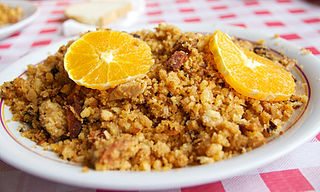
Migas is a dish traditionally made from stale bread and other ingredients in Spanish and Portuguese cuisines. Originally introduced by shepherds, migas are very popular across the Iberian Peninsula, and are the typical breakfast of hunters at monterías in southern Spain.
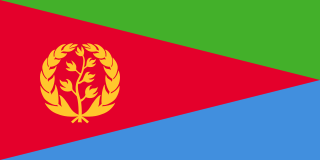
Eritrean cuisine is based on Eritrea's native culinary traditions, but also arises from social interchanges with other regions. The local cuisine shares very strong similarities with the cuisine of neighboring Ethiopia with several dishes being cultural to both nations as a result of the two nations having been unified for hundreds of years. It also has influences from Italian cuisine due to the Italian colonization of the nation, and minor influences from other cuisines in the region.
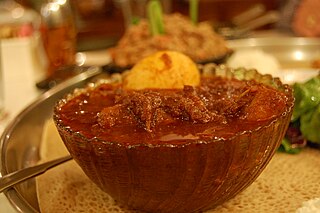
Wat or wet or ito or tsebhi is an Ethiopian and Eritrean stew that may be prepared with chicken, beef, lamb, a variety of vegetables, spice mixtures such as berbere , and niter kibbeh, a seasoned clarified butter.
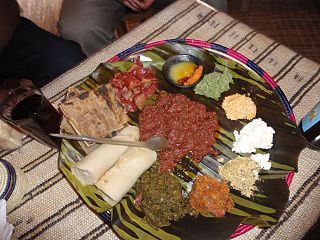
Niter kibbeh, or niter qibe, also called tesmi, is a seasoned, clarified butter used in Ethiopian and Eritrean cuisine. Its preparation is similar to that of ghee, but niter kibbeh is simmered with spices such as besobela, koseret, fenugreek, cumin, coriander, turmeric, Ethiopian cardamom (korarima), cinnamon, or nutmeg before straining, imparting a distinct, spicy aroma. The version using vegetable oil instead of butter is called yeqimem zeyet.

Ful medames, or simply fūl, is a stew of cooked fava beans served with olive oil, cumin, and optionally with chopped parsley, garlic, onion, lemon juice, chili pepper and other vegetables, herbs, and spices. Ful medames is traditionally made in and served out of a large metal jug. It is notably a staple food in Egypt and is considered a national dish, especially in the northern cities of Cairo and Gizah. Fava beans can sometimes be also found in other cuisines in the Middle East, and Africa, though cooked differently.
Habesha peoples is an ethnic or pan-ethnic identifier that has been historically employed to refer to Semitic-speaking and predominantly Oriental Orthodox Christian peoples found in the highlands of Ethiopia and Eritrea between Asmara and Addis Ababa and this usage remains common today. The term is also used in varying degrees of inclusion and exclusion of other groups.

Kitfo is an Ethiopian traditional dish that originated among the Gurage people. It consists of minced raw beef, marinated in mitmita and niter kibbeh. The word comes from the Ethio-Semitic root k-t-f, meaning "to chop finely; mince."

Gored gored, is a raw beef dish eaten in Ethiopia. Whereas kitfo is minced beef marinated in spices and clarified butter, gored gored is cubed and left unmarinated. Like kitfo, it is widely popular and considered a national dish. It is often served with mitmita and awaze.

Shiro, also called shiro wat, or tsebhi shiro, is a stew served for either lunch or dinner, originating from Northern Ethiopia and Southern Eritrea. An essential part of Eritrean and Ethiopian cuisine, its primary ingredient is powdered chickpeas or broad bean meal and often prepared with the addition of minced onions, garlic and, depending upon regional variation, ground ginger or chopped tomatoes and chili-peppers. Shiro is served atop injera or kitcha. Tegabino shiro is a type of shiro made from heavily spiced legume, chickpea, field pea, or fava bean, oil, and water. It is brought bubbling to the table in a miniature clay pot or shallow aluminum pan. It is often consumed with dark or sergegna injera.

Genfo, Ga’at, or Marca is a stiff porridge-like substance that is normally formed into a round shape with a hole in the middle for the dipping sauce, a mixture of butter and red peppers, or pulses such as sunflower, seed, nut and flax.

Kitcha is a relatively thin unleavened bread typical of Ethiopian and Eritrean cuisine. It is generally made with wheat flour, water, and salt. It is cooked in a hot pan free-form until one side is cooked. It is then picked up and cooked on the other side. Slight burning on each side is often seen.
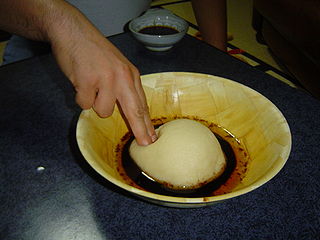
Asida is a common dish in the Arab world. It is a lump of dough, obtained by stirring wheat flour into boiling water, sometimes with added butter or honey. Similar in texture to fufu, it is eaten mainly in Middle East and African countries. It is considered one of the most popular desserts and traditional dishes in many Arab countries.

Italian Eritrean cuisine is the mix of Eritrean dishes and spices with Italian dishes.

Djiboutian cuisine is a mixture of Somali, Afar, Yemeni, and French cuisine, with some additional South Asian culinary influences.

Injera is a sour fermented pancake-like flatbread with a slightly spongy texture, traditionally made of teff flour. In Ethiopia and Eritrea, injera is a staple. Injera is central to the dining process in Amhara community, like bread or rice elsewhere and is usually stored in the mesob.
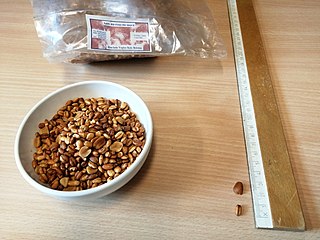
Dabo kolo is an Ethiopian and Eritrean snack and finger food consisting of small pieces of spiced fried dough. Dabo kolo means corn bread in the Amharic language, with dabo for bread, and kolo for corn or roasted barley, chickpeas, sunflower seeds, other local grains and peanuts.
Ethiopian Jewish cuisine is the cuisine of the Beta Israel. The cuisine of the Ethiopian Jews is similar to the cuisine of other Ethiopians, with some variations.

Zigni, kaih tsebhi or kai wat is a popular Eritrean and Ethiopian stew made from meat, tomatoes, red onions and Berbere spices. The meat can be beef, lamb, goat, or chicken and usually placed on a plate of injera, a type of unleavened bread made from teff flour. It can be eaten for lunch or dinner. The dish requires a relatively long amount of time but not a lot of active effort to make. The traditional recipe can take as long as five to six hours to prepare. As such, it is sometimes reserved for special occasions. The Berbere spices can make the zigni spicy and give it a red color.
















